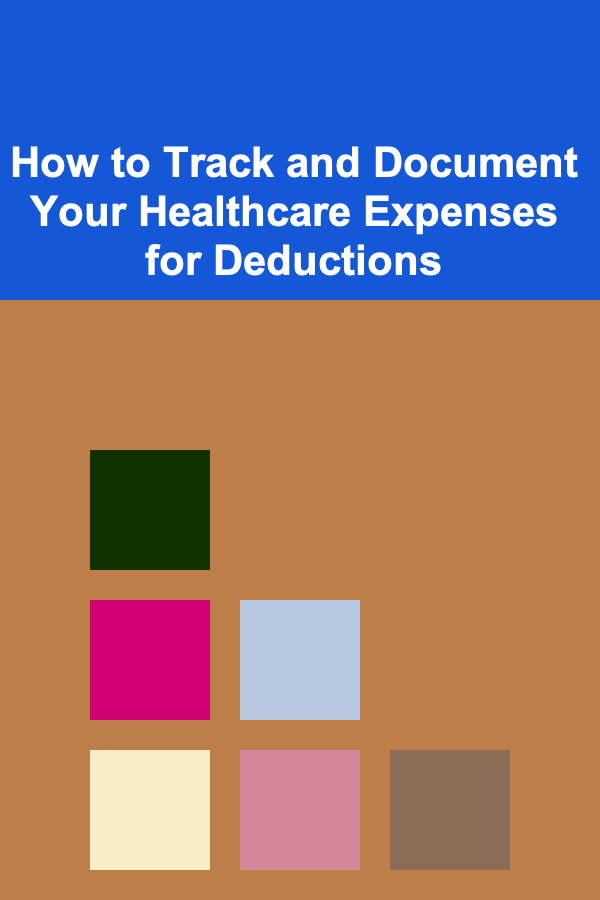
How to Track and Document Your Healthcare Expenses for Deductions
ebook include PDF & Audio bundle (Micro Guide)
$12.99$6.99
Limited Time Offer! Order within the next:

Healthcare expenses can be one of the most significant financial burdens for individuals and families. However, many of these expenses can be deducted from your taxes, potentially lowering your taxable income and reducing the amount you owe. Understanding how to properly track and document your healthcare expenses is crucial for maximizing these deductions and ensuring that you're taking full advantage of the tax benefits available to you.
In this article, we will explore the process of tracking and documenting healthcare expenses for tax deductions. We'll dive into which expenses qualify, how to keep accurate records, and how to utilize these deductions to reduce your overall tax liability.
Understanding Healthcare Expense Deductions
Before diving into the specifics of tracking and documenting healthcare expenses, it's essential to understand what qualifies for healthcare deductions. The IRS allows taxpayers to deduct medical and dental expenses that exceed a certain percentage of their adjusted gross income (AGI).
Qualifying Medical Expenses
According to the IRS, qualified medical expenses are those that are primarily intended to alleviate or prevent a physical or mental illness. Some of the most common medical expenses that qualify for deductions include:
- Doctor and Dentist Visits: Payments made to medical providers for professional services.
- Hospital Services: Costs for inpatient or outpatient care at a hospital.
- Prescription Drugs: The cost of prescribed medications.
- Medical Equipment: Costs of items like wheelchairs, hearing aids, and eyeglasses.
- Health Insurance Premiums: Premiums paid for health insurance, including Medicare and long-term care insurance.
- Therapies: Physical, occupational, and other forms of therapy.
- Dental and Vision Care: Expenses related to teeth cleaning, fillings, eye exams, glasses, or contact lenses.
- Mental Health Care: Expenses for therapy and counseling services for mental health conditions.
Non-Qualifying Expenses
It's important to be aware of what doesn't qualify for healthcare deductions. These expenses might include:
- Cosmetic Surgery: Expenses for purely cosmetic procedures.
- Non-prescribed Over-the-Counter Medications: General health items that don't require a prescription.
- Elective Procedures: Expenses for elective procedures that are not medically necessary.
Deduction Limits and Thresholds
For most taxpayers, medical expenses are deductible only to the extent that they exceed 7.5% of their AGI. For instance, if your AGI is $50,000, you would need to have medical expenses that exceed $3,750 (7.5% of $50,000) before you can claim the deduction.
In addition, you can deduct both the expenses you paid out of pocket and any expenses reimbursed by insurance, but you must subtract any reimbursements from your total claim.
How to Track Healthcare Expenses
Now that we understand what qualifies as a deductible healthcare expense, let's look at the most effective ways to track these expenses throughout the year. Proper tracking is essential for ensuring that you don't miss out on any potential deductions and that you can present an accurate picture of your healthcare costs when tax season arrives.
1. Keep a Detailed Record of All Medical Transactions
The first step in tracking your healthcare expenses is to keep a detailed record of every medical transaction. This includes payments for medical services, doctor's visits, prescription medications, dental care, and any other medical expenses.
How to track:
- Receipts: Always ask for receipts whenever you pay for medical services. These receipts should include the name of the service provider, the date of the service, the amount paid, and a description of the service.
- Statements: Some healthcare providers will send you monthly or quarterly statements outlining the services rendered and the balance due. Keep these statements in a safe place for reference.
- Online Accounts: If you use an online portal to pay for medical services or prescriptions, download your transaction history at the end of each month.
2. Utilize a Healthcare Expense Tracker
There are a variety of tools and software available for tracking your healthcare expenses. Many of these tools allow you to categorize your expenses, upload receipts, and even sync with your bank or credit card accounts to automatically track payments.
Some popular healthcare expense tracking tools include:
- Mint: A budgeting app that allows you to track medical expenses by linking your bank and credit card accounts.
- Expense Tracker: Apps specifically designed to track medical and healthcare-related expenses.
- Spreadsheet: If you prefer a more hands-on approach, you can create your own spreadsheet using software like Microsoft Excel or Google Sheets to log each healthcare expense.
3. Track Insurance Reimbursements and Benefits
When you file for healthcare expense deductions, it's essential to track both your out-of-pocket expenses and any reimbursements you receive from your health insurance plan. This will ensure that you don't accidentally double-count or overestimate your deductions.
How to track:
- Insurance Statements: Most insurance providers send out Explanation of Benefits (EOB) statements, which summarize the services covered and how much the insurer paid. Keep these statements for reference when filing your taxes.
- Reimbursement Records: If your insurance plan reimburses you for any medical costs, track these reimbursements and subtract them from your total healthcare expenses to avoid claiming the same amount twice.
4. Monitor and Track Health Savings Accounts (HSAs) and Flexible Spending Accounts (FSAs)
If you contribute to an HSA or FSA, these accounts are designed to help you pay for qualified medical expenses using tax-free funds. However, when using an HSA or FSA, the money you use from these accounts cannot be claimed as a deduction again.
How to track:
- Account Statements: Regularly review your HSA or FSA account statements to ensure that the expenses are being properly tracked.
- Contribution Limits: Be aware of the contribution limits for HSAs and FSAs and ensure you stay within those limits.
5. Track Travel Costs for Medical Purposes
In some cases, you may also be able to deduct travel costs if you need to travel for medical treatment. This includes the cost of driving to and from medical appointments or traveling to a specialized treatment center.
How to track:
- Mileage: Keep a record of the miles you drive for medical purposes. You can calculate your deduction based on the IRS mileage rate, which changes each year.
- Receipts: Keep receipts for any tolls, parking fees, or other travel-related costs you incur when traveling for medical treatment.
6. Monitor Long-Term Care Expenses
Long-term care expenses can also qualify for tax deductions, but they are subject to specific rules. If you or a family member are receiving long-term care services, you may be able to deduct a portion of these costs.
How to track:
- Caregiver Payments: If you are paying for professional caregiving services, track the payments made and keep records of the caregiver's details and services.
- Assisted Living: If you live in an assisted living facility or nursing home, track the expenses related to care, meals, and housing.
7. Organize Your Documentation Throughout the Year
As you accumulate receipts, statements, and invoices throughout the year, it's important to organize them in a way that makes it easy to access when tax season arrives. Having a filing system or digital storage method will ensure that your records are readily available when it's time to file.
How to organize:
- Folders: Create a physical or digital folder to store all healthcare-related documentation.
- Tax Software: If you use tax preparation software, you can upload your receipts and invoices directly into the system to keep them organized.
- Cloud Storage: Use cloud-based storage options, such as Google Drive or Dropbox, to store scanned copies of receipts and medical documents.
How to Maximize Your Healthcare Deductions
Once you have tracked your healthcare expenses and organized the documentation, the next step is to use these records to maximize your deductions.
1. Itemize Your Deductions
To claim healthcare expenses on your taxes, you must itemize your deductions on Schedule A of your tax return. Itemizing allows you to deduct medical expenses that exceed 7.5% of your AGI.
2. Claim Eligible Medical Expenses
Ensure that you only claim medical expenses that meet the IRS guidelines. Keep detailed records, including receipts and statements, to support your claims in case of an audit.
3. Review the Tax Code for Updates
Tax laws change frequently, and what qualifies as a deductible expense may change from year to year. Be sure to review IRS publications or consult with a tax professional to ensure you're up-to-date on the latest tax rules.
4. Consult a Tax Professional
If you're unsure about the deductions you can claim or how to track your healthcare expenses, it's always a good idea to consult with a tax professional. They can help you navigate the complexities of healthcare deductions and ensure you're following the correct procedures.
Conclusion
Tracking and documenting healthcare expenses is a crucial part of maximizing your tax deductions. By carefully keeping records of your medical, dental, and vision expenses, as well as any other qualifying costs, you can reduce your taxable income and potentially save money. Whether you choose to use manual methods, like spreadsheets, or automated tools, consistency and organization are key to ensuring you don't miss out on potential savings. With proper tracking and documentation, healthcare expenses can become an essential part of your tax strategy, helping you keep more of your hard-earned money.
Reading More From Our Other Websites
- [Organization Tip 101] How to Use Labels Effectively in Your Home Organization
- [Organization Tip 101] How to Organize Your Favorite Board Games for Easy Access
- [Toy Making Tip 101] Best Fabric Scrap Toy Making: Upcycling Fabrics into Adorable Plushies and Sensory Toys
- [Home Holiday Decoration 101] How to Make Your First Christmas in a New Home Special
- [Personal Care Tips 101] How to Develop a Nail Care Routine That Lasts All Week
- [Needle Felting Tip 101] How to Craft Hyper‑Realistic Feathered Birds Using Advanced Needle Felting Techniques
- [Home Budget Decorating 101] How to Style Your Sofa on a Shoestring: Budget-Friendly Decorating with Blankets and Throws Hacks
- [Home Budget Decorating 101] How to Create a Functional Yet Stylish Kitchen on a Budget
- [Home Security 101] How to Secure Your Home When You Have Children or Pets
- [Stamp Making Tip 101] From Hobby to Handcraft: Mastering the Art of Stamp Making

How to Create a Digital Library of DIY Resources
Read More
How to Create More Storage in Your Home with Custom Built-Ins
Read More
How to Use Weatherstripping for Better Soundproofing
Read More
How To Choose the Right Lip Scrub for Smoothness
Read More
The Step-by-Step Guide to Playing Guitar Chords
Read More
10 Tips for Improving Communication with Carriers and Customers
Read MoreOther Products

How to Create a Digital Library of DIY Resources
Read More
How to Create More Storage in Your Home with Custom Built-Ins
Read More
How to Use Weatherstripping for Better Soundproofing
Read More
How To Choose the Right Lip Scrub for Smoothness
Read More
The Step-by-Step Guide to Playing Guitar Chords
Read More